Comprehensive Analysis: Facilitating Changes in Health and Social Care
VerifiedAdded on 2019/12/03
|17
|4607
|173
Report
AI Summary
This report provides a comprehensive analysis of change management within health and social care services. It begins by identifying key factors that drive change, such as economic, legal, cultural, social, and technical influences, and examines the challenges these factors present. The report then proposes strategies and criteria for measuring recent changes, including regulatory inspections, quality assurance systems, and user feedback, while assessing the impact of these changes on operations, staff, and service users. Furthermore, it explores the principles of change management using Leavitt's model and suggests effective ways to plan and monitor changes within health and social care settings, offering recommendations for service responses to ensure positive outcomes. The report concludes by providing a detailed evaluation of the overall impact of these changes and their implications for the future of health and social care.
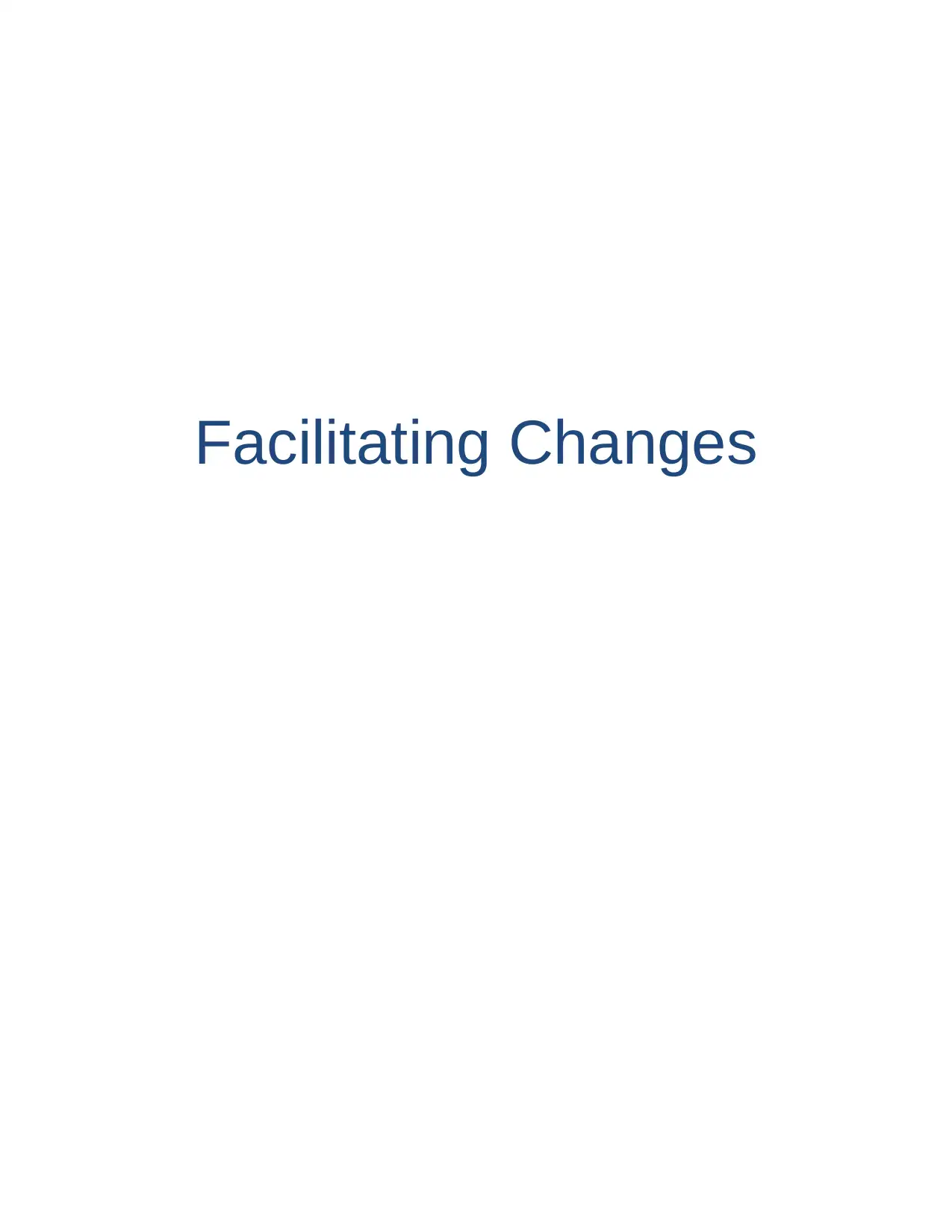
Facilitating Changes
Paraphrase This Document
Need a fresh take? Get an instant paraphrase of this document with our AI Paraphraser
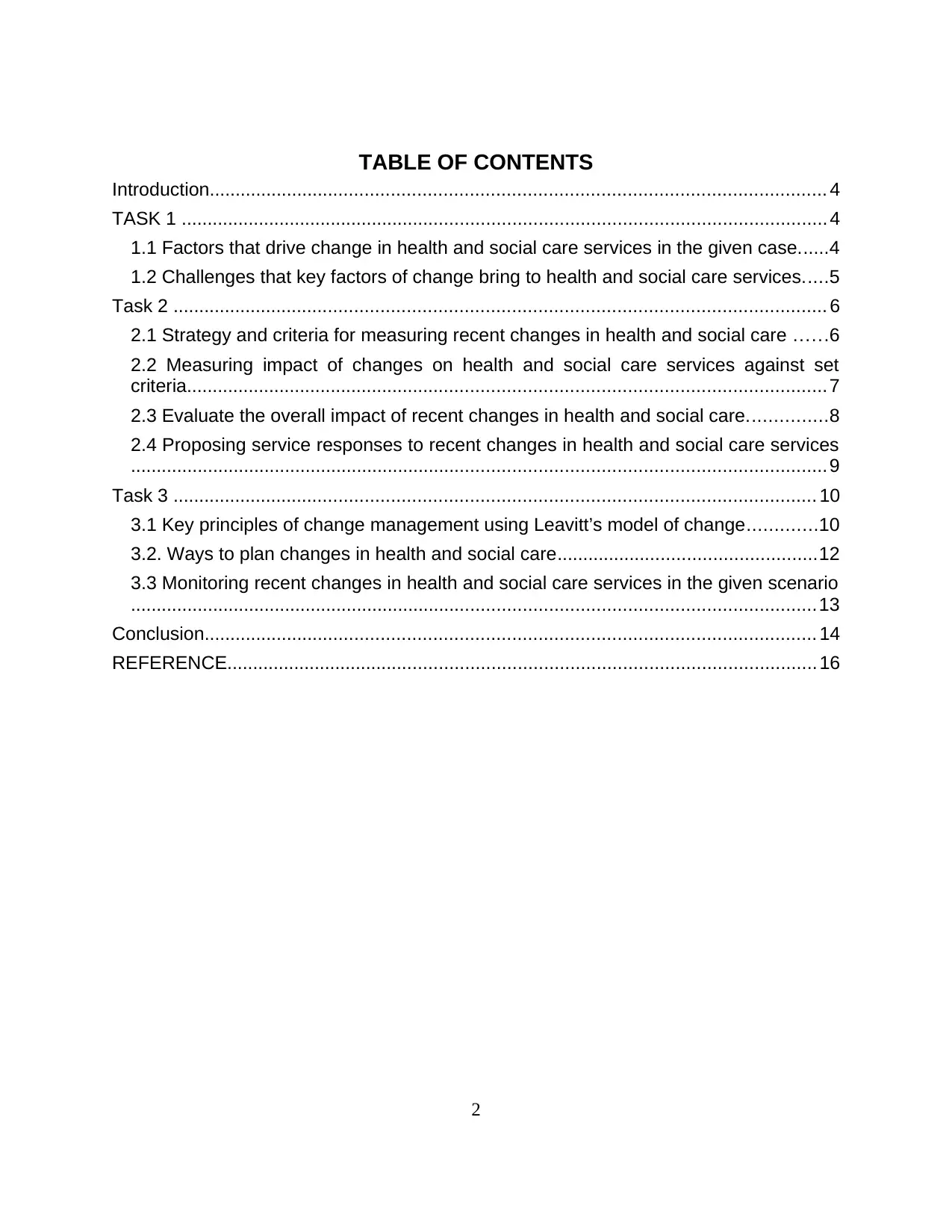
TABLE OF CONTENTS
Introduction...................................................................................................................... 4
TASK 1 ............................................................................................................................ 4
1.1 Factors that drive change in health and social care services in the given case......4
1.2 Challenges that key factors of change bring to health and social care services.....5
Task 2 ............................................................................................................................. 6
2.1 Strategy and criteria for measuring recent changes in health and social care ......6
2.2 Measuring impact of changes on health and social care services against set
criteria........................................................................................................................... 7
2.3 Evaluate the overall impact of recent changes in health and social care...............8
2.4 Proposing service responses to recent changes in health and social care services
......................................................................................................................................9
Task 3 ........................................................................................................................... 10
3.1 Key principles of change management using Leavitt’s model of change.............10
3.2. Ways to plan changes in health and social care..................................................12
3.3 Monitoring recent changes in health and social care services in the given scenario
....................................................................................................................................13
Conclusion..................................................................................................................... 14
REFERENCE................................................................................................................. 16
2
Introduction...................................................................................................................... 4
TASK 1 ............................................................................................................................ 4
1.1 Factors that drive change in health and social care services in the given case......4
1.2 Challenges that key factors of change bring to health and social care services.....5
Task 2 ............................................................................................................................. 6
2.1 Strategy and criteria for measuring recent changes in health and social care ......6
2.2 Measuring impact of changes on health and social care services against set
criteria........................................................................................................................... 7
2.3 Evaluate the overall impact of recent changes in health and social care...............8
2.4 Proposing service responses to recent changes in health and social care services
......................................................................................................................................9
Task 3 ........................................................................................................................... 10
3.1 Key principles of change management using Leavitt’s model of change.............10
3.2. Ways to plan changes in health and social care..................................................12
3.3 Monitoring recent changes in health and social care services in the given scenario
....................................................................................................................................13
Conclusion..................................................................................................................... 14
REFERENCE................................................................................................................. 16
2
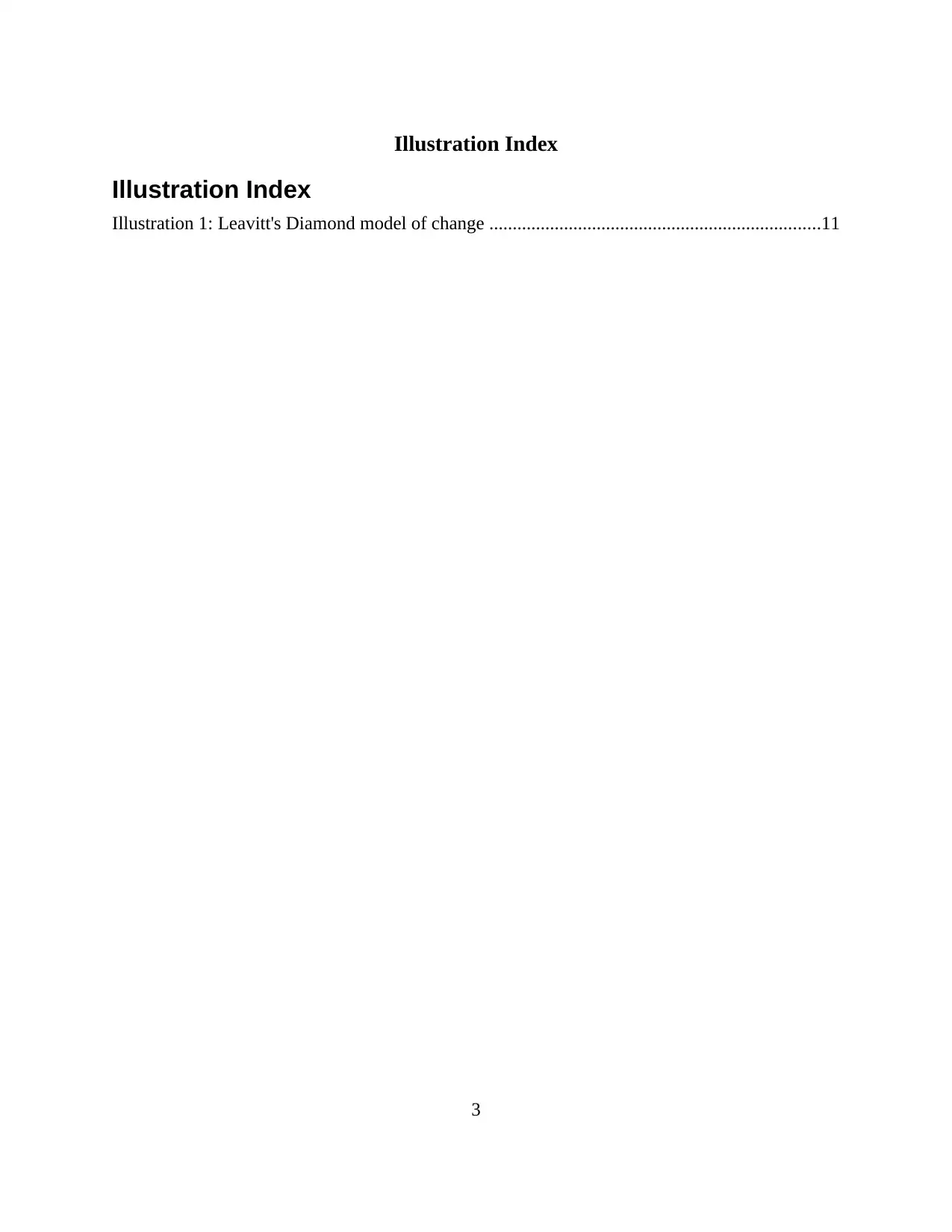
Illustration Index
Illustration Index
Illustration 1: Leavitt's Diamond model of change .......................................................................11
3
Illustration Index
Illustration 1: Leavitt's Diamond model of change .......................................................................11
3
⊘ This is a preview!⊘
Do you want full access?
Subscribe today to unlock all pages.

Trusted by 1+ million students worldwide
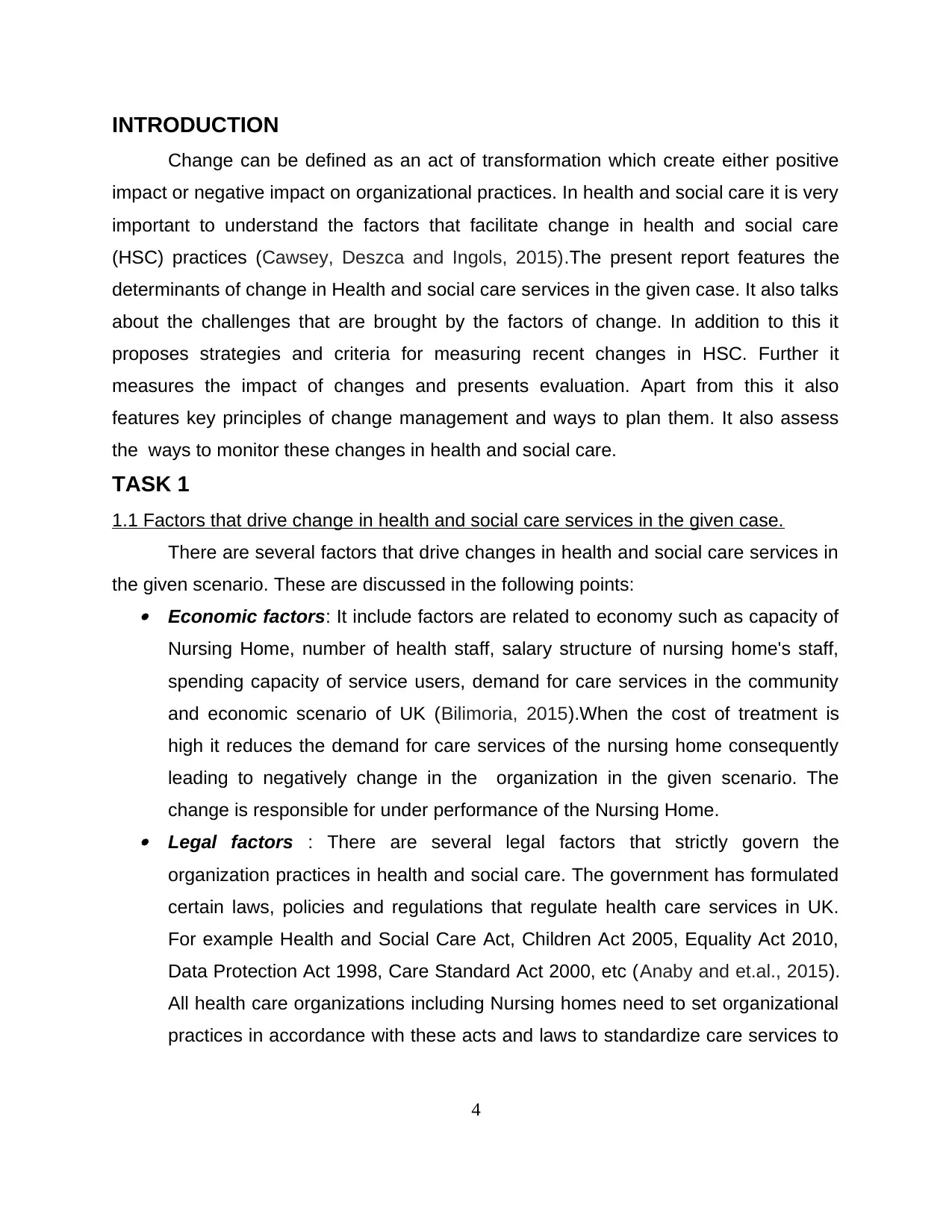
INTRODUCTION
Change can be defined as an act of transformation which create either positive
impact or negative impact on organizational practices. In health and social care it is very
important to understand the factors that facilitate change in health and social care
(HSC) practices (Cawsey, Deszca and Ingols, 2015).The present report features the
determinants of change in Health and social care services in the given case. It also talks
about the challenges that are brought by the factors of change. In addition to this it
proposes strategies and criteria for measuring recent changes in HSC. Further it
measures the impact of changes and presents evaluation. Apart from this it also
features key principles of change management and ways to plan them. It also assess
the ways to monitor these changes in health and social care.
TASK 1
1.1 Factors that drive change in health and social care services in the given case.
There are several factors that drive changes in health and social care services in
the given scenario. These are discussed in the following points: Economic factors: It include factors are related to economy such as capacity of
Nursing Home, number of health staff, salary structure of nursing home's staff,
spending capacity of service users, demand for care services in the community
and economic scenario of UK (Bilimoria, 2015).When the cost of treatment is
high it reduces the demand for care services of the nursing home consequently
leading to negatively change in the organization in the given scenario. The
change is responsible for under performance of the Nursing Home. Legal factors : There are several legal factors that strictly govern the
organization practices in health and social care. The government has formulated
certain laws, policies and regulations that regulate health care services in UK.
For example Health and Social Care Act, Children Act 2005, Equality Act 2010,
Data Protection Act 1998, Care Standard Act 2000, etc (Anaby and et.al., 2015).
All health care organizations including Nursing homes need to set organizational
practices in accordance with these acts and laws to standardize care services to
4
Change can be defined as an act of transformation which create either positive
impact or negative impact on organizational practices. In health and social care it is very
important to understand the factors that facilitate change in health and social care
(HSC) practices (Cawsey, Deszca and Ingols, 2015).The present report features the
determinants of change in Health and social care services in the given case. It also talks
about the challenges that are brought by the factors of change. In addition to this it
proposes strategies and criteria for measuring recent changes in HSC. Further it
measures the impact of changes and presents evaluation. Apart from this it also
features key principles of change management and ways to plan them. It also assess
the ways to monitor these changes in health and social care.
TASK 1
1.1 Factors that drive change in health and social care services in the given case.
There are several factors that drive changes in health and social care services in
the given scenario. These are discussed in the following points: Economic factors: It include factors are related to economy such as capacity of
Nursing Home, number of health staff, salary structure of nursing home's staff,
spending capacity of service users, demand for care services in the community
and economic scenario of UK (Bilimoria, 2015).When the cost of treatment is
high it reduces the demand for care services of the nursing home consequently
leading to negatively change in the organization in the given scenario. The
change is responsible for under performance of the Nursing Home. Legal factors : There are several legal factors that strictly govern the
organization practices in health and social care. The government has formulated
certain laws, policies and regulations that regulate health care services in UK.
For example Health and Social Care Act, Children Act 2005, Equality Act 2010,
Data Protection Act 1998, Care Standard Act 2000, etc (Anaby and et.al., 2015).
All health care organizations including Nursing homes need to set organizational
practices in accordance with these acts and laws to standardize care services to
4
Paraphrase This Document
Need a fresh take? Get an instant paraphrase of this document with our AI Paraphraser
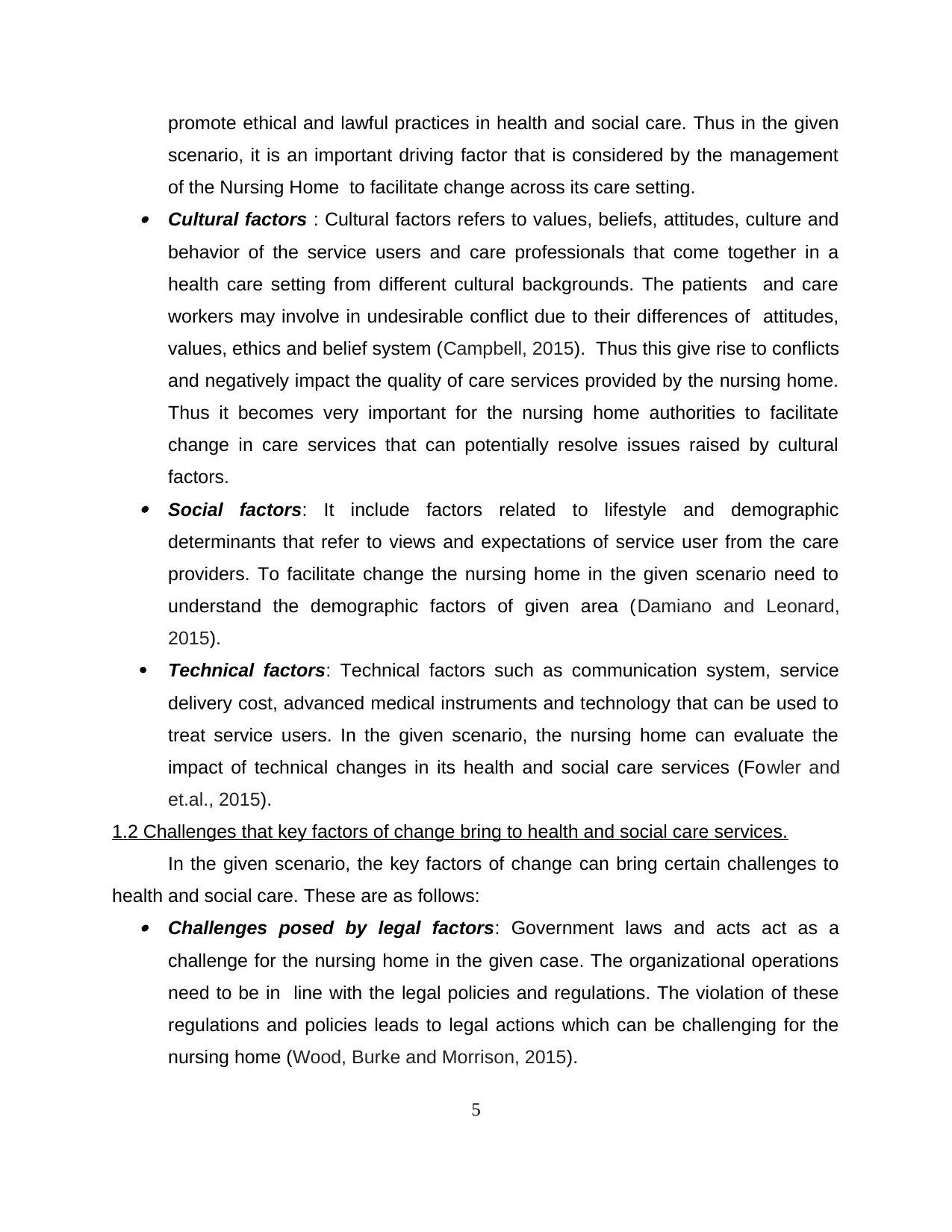
promote ethical and lawful practices in health and social care. Thus in the given
scenario, it is an important driving factor that is considered by the management
of the Nursing Home to facilitate change across its care setting. Cultural factors : Cultural factors refers to values, beliefs, attitudes, culture and
behavior of the service users and care professionals that come together in a
health care setting from different cultural backgrounds. The patients and care
workers may involve in undesirable conflict due to their differences of attitudes,
values, ethics and belief system (Campbell, 2015). Thus this give rise to conflicts
and negatively impact the quality of care services provided by the nursing home.
Thus it becomes very important for the nursing home authorities to facilitate
change in care services that can potentially resolve issues raised by cultural
factors. Social factors: It include factors related to lifestyle and demographic
determinants that refer to views and expectations of service user from the care
providers. To facilitate change the nursing home in the given scenario need to
understand the demographic factors of given area (Damiano and Leonard,
2015).
Technical factors: Technical factors such as communication system, service
delivery cost, advanced medical instruments and technology that can be used to
treat service users. In the given scenario, the nursing home can evaluate the
impact of technical changes in its health and social care services (Fowler and
et.al., 2015).
1.2 Challenges that key factors of change bring to health and social care services.
In the given scenario, the key factors of change can bring certain challenges to
health and social care. These are as follows: Challenges posed by legal factors: Government laws and acts act as a
challenge for the nursing home in the given case. The organizational operations
need to be in line with the legal policies and regulations. The violation of these
regulations and policies leads to legal actions which can be challenging for the
nursing home (Wood, Burke and Morrison, 2015).
5
scenario, it is an important driving factor that is considered by the management
of the Nursing Home to facilitate change across its care setting. Cultural factors : Cultural factors refers to values, beliefs, attitudes, culture and
behavior of the service users and care professionals that come together in a
health care setting from different cultural backgrounds. The patients and care
workers may involve in undesirable conflict due to their differences of attitudes,
values, ethics and belief system (Campbell, 2015). Thus this give rise to conflicts
and negatively impact the quality of care services provided by the nursing home.
Thus it becomes very important for the nursing home authorities to facilitate
change in care services that can potentially resolve issues raised by cultural
factors. Social factors: It include factors related to lifestyle and demographic
determinants that refer to views and expectations of service user from the care
providers. To facilitate change the nursing home in the given scenario need to
understand the demographic factors of given area (Damiano and Leonard,
2015).
Technical factors: Technical factors such as communication system, service
delivery cost, advanced medical instruments and technology that can be used to
treat service users. In the given scenario, the nursing home can evaluate the
impact of technical changes in its health and social care services (Fowler and
et.al., 2015).
1.2 Challenges that key factors of change bring to health and social care services.
In the given scenario, the key factors of change can bring certain challenges to
health and social care. These are as follows: Challenges posed by legal factors: Government laws and acts act as a
challenge for the nursing home in the given case. The organizational operations
need to be in line with the legal policies and regulations. The violation of these
regulations and policies leads to legal actions which can be challenging for the
nursing home (Wood, Burke and Morrison, 2015).
5
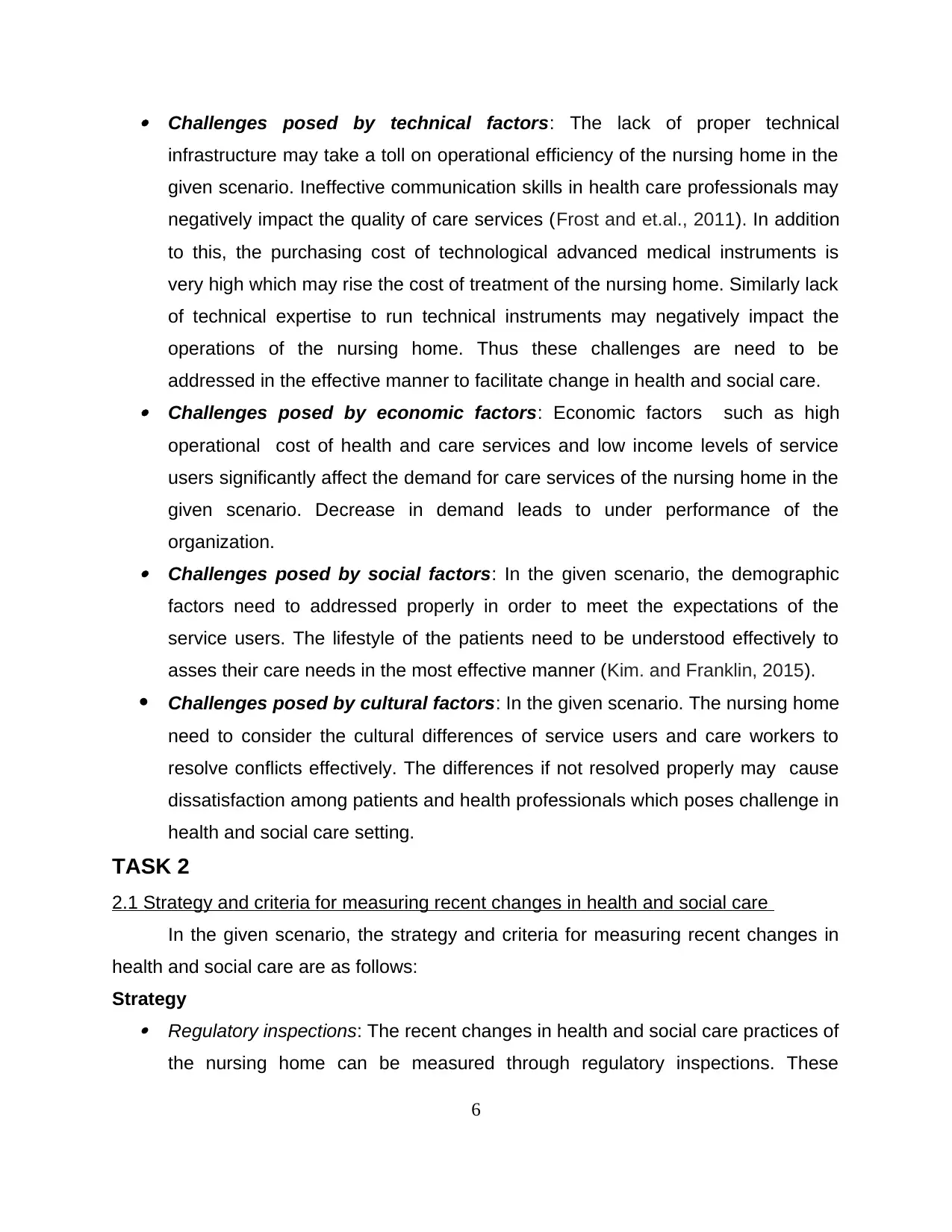
Challenges posed by technical factors: The lack of proper technical
infrastructure may take a toll on operational efficiency of the nursing home in the
given scenario. Ineffective communication skills in health care professionals may
negatively impact the quality of care services (Frost and et.al., 2011). In addition
to this, the purchasing cost of technological advanced medical instruments is
very high which may rise the cost of treatment of the nursing home. Similarly lack
of technical expertise to run technical instruments may negatively impact the
operations of the nursing home. Thus these challenges are need to be
addressed in the effective manner to facilitate change in health and social care. Challenges posed by economic factors: Economic factors such as high
operational cost of health and care services and low income levels of service
users significantly affect the demand for care services of the nursing home in the
given scenario. Decrease in demand leads to under performance of the
organization. Challenges posed by social factors: In the given scenario, the demographic
factors need to addressed properly in order to meet the expectations of the
service users. The lifestyle of the patients need to be understood effectively to
asses their care needs in the most effective manner (Kim. and Franklin, 2015).
Challenges posed by cultural factors: In the given scenario. The nursing home
need to consider the cultural differences of service users and care workers to
resolve conflicts effectively. The differences if not resolved properly may cause
dissatisfaction among patients and health professionals which poses challenge in
health and social care setting.
TASK 2
2.1 Strategy and criteria for measuring recent changes in health and social care
In the given scenario, the strategy and criteria for measuring recent changes in
health and social care are as follows:
Strategy Regulatory inspections: The recent changes in health and social care practices of
the nursing home can be measured through regulatory inspections. These
6
infrastructure may take a toll on operational efficiency of the nursing home in the
given scenario. Ineffective communication skills in health care professionals may
negatively impact the quality of care services (Frost and et.al., 2011). In addition
to this, the purchasing cost of technological advanced medical instruments is
very high which may rise the cost of treatment of the nursing home. Similarly lack
of technical expertise to run technical instruments may negatively impact the
operations of the nursing home. Thus these challenges are need to be
addressed in the effective manner to facilitate change in health and social care. Challenges posed by economic factors: Economic factors such as high
operational cost of health and care services and low income levels of service
users significantly affect the demand for care services of the nursing home in the
given scenario. Decrease in demand leads to under performance of the
organization. Challenges posed by social factors: In the given scenario, the demographic
factors need to addressed properly in order to meet the expectations of the
service users. The lifestyle of the patients need to be understood effectively to
asses their care needs in the most effective manner (Kim. and Franklin, 2015).
Challenges posed by cultural factors: In the given scenario. The nursing home
need to consider the cultural differences of service users and care workers to
resolve conflicts effectively. The differences if not resolved properly may cause
dissatisfaction among patients and health professionals which poses challenge in
health and social care setting.
TASK 2
2.1 Strategy and criteria for measuring recent changes in health and social care
In the given scenario, the strategy and criteria for measuring recent changes in
health and social care are as follows:
Strategy Regulatory inspections: The recent changes in health and social care practices of
the nursing home can be measured through regulatory inspections. These
6
⊘ This is a preview!⊘
Do you want full access?
Subscribe today to unlock all pages.

Trusted by 1+ million students worldwide
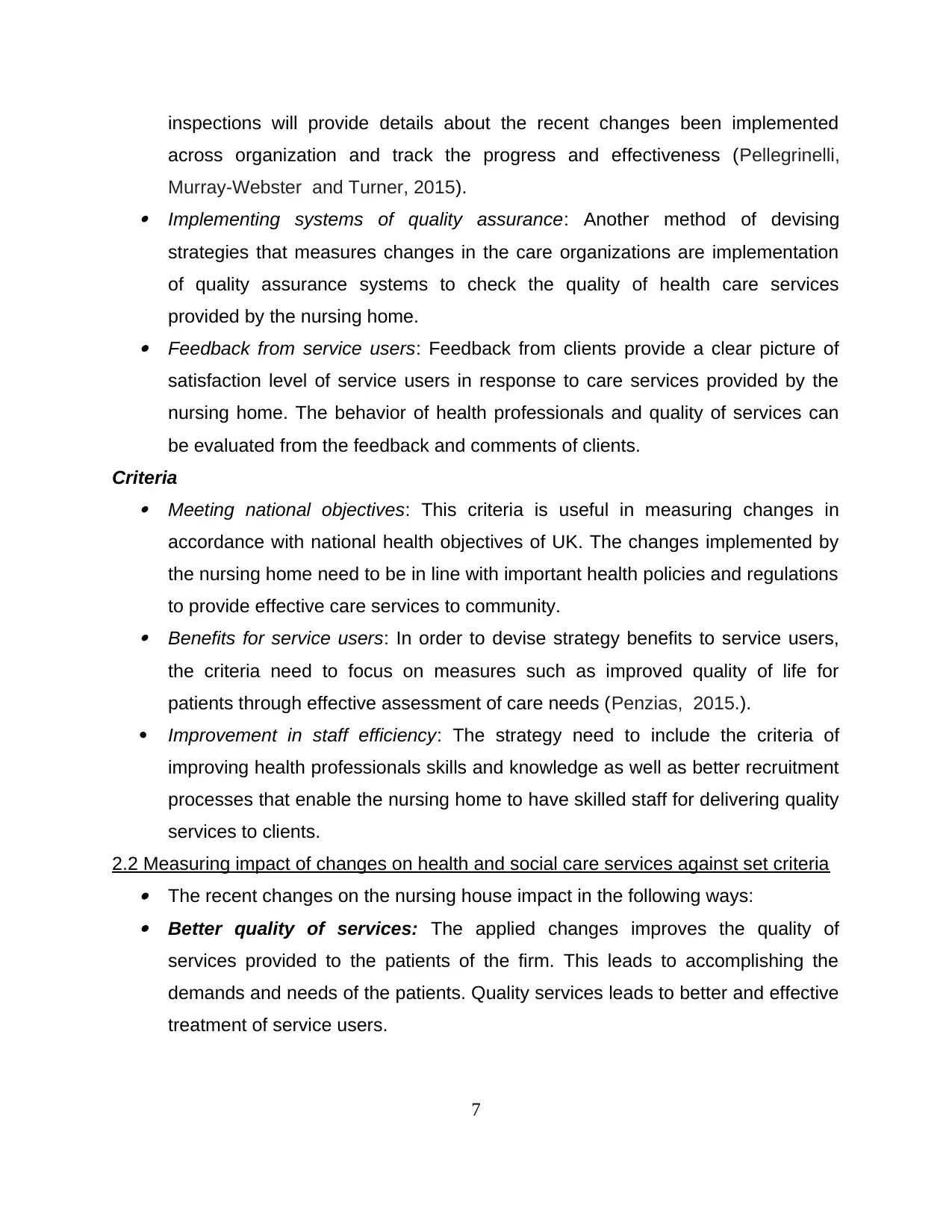
inspections will provide details about the recent changes been implemented
across organization and track the progress and effectiveness (Pellegrinelli,
Murray-Webster and Turner, 2015). Implementing systems of quality assurance: Another method of devising
strategies that measures changes in the care organizations are implementation
of quality assurance systems to check the quality of health care services
provided by the nursing home. Feedback from service users: Feedback from clients provide a clear picture of
satisfaction level of service users in response to care services provided by the
nursing home. The behavior of health professionals and quality of services can
be evaluated from the feedback and comments of clients.
Criteria Meeting national objectives: This criteria is useful in measuring changes in
accordance with national health objectives of UK. The changes implemented by
the nursing home need to be in line with important health policies and regulations
to provide effective care services to community. Benefits for service users: In order to devise strategy benefits to service users,
the criteria need to focus on measures such as improved quality of life for
patients through effective assessment of care needs (Penzias, 2015.).
Improvement in staff efficiency: The strategy need to include the criteria of
improving health professionals skills and knowledge as well as better recruitment
processes that enable the nursing home to have skilled staff for delivering quality
services to clients.
2.2 Measuring impact of changes on health and social care services against set criteria The recent changes on the nursing house impact in the following ways: Better quality of services: The applied changes improves the quality of
services provided to the patients of the firm. This leads to accomplishing the
demands and needs of the patients. Quality services leads to better and effective
treatment of service users.
7
across organization and track the progress and effectiveness (Pellegrinelli,
Murray-Webster and Turner, 2015). Implementing systems of quality assurance: Another method of devising
strategies that measures changes in the care organizations are implementation
of quality assurance systems to check the quality of health care services
provided by the nursing home. Feedback from service users: Feedback from clients provide a clear picture of
satisfaction level of service users in response to care services provided by the
nursing home. The behavior of health professionals and quality of services can
be evaluated from the feedback and comments of clients.
Criteria Meeting national objectives: This criteria is useful in measuring changes in
accordance with national health objectives of UK. The changes implemented by
the nursing home need to be in line with important health policies and regulations
to provide effective care services to community. Benefits for service users: In order to devise strategy benefits to service users,
the criteria need to focus on measures such as improved quality of life for
patients through effective assessment of care needs (Penzias, 2015.).
Improvement in staff efficiency: The strategy need to include the criteria of
improving health professionals skills and knowledge as well as better recruitment
processes that enable the nursing home to have skilled staff for delivering quality
services to clients.
2.2 Measuring impact of changes on health and social care services against set criteria The recent changes on the nursing house impact in the following ways: Better quality of services: The applied changes improves the quality of
services provided to the patients of the firm. This leads to accomplishing the
demands and needs of the patients. Quality services leads to better and effective
treatment of service users.
7
Paraphrase This Document
Need a fresh take? Get an instant paraphrase of this document with our AI Paraphraser
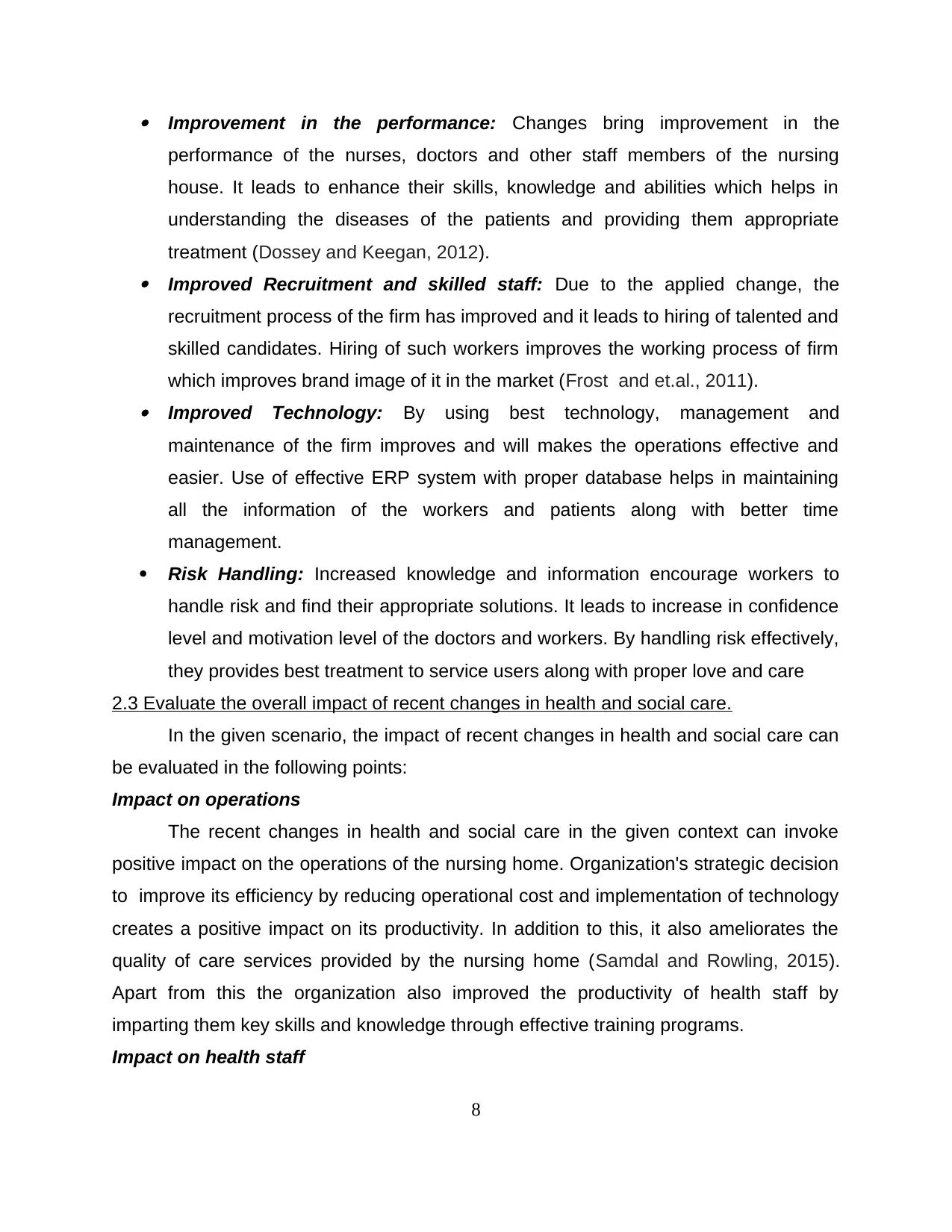
Improvement in the performance: Changes bring improvement in the
performance of the nurses, doctors and other staff members of the nursing
house. It leads to enhance their skills, knowledge and abilities which helps in
understanding the diseases of the patients and providing them appropriate
treatment (Dossey and Keegan, 2012). Improved Recruitment and skilled staff: Due to the applied change, the
recruitment process of the firm has improved and it leads to hiring of talented and
skilled candidates. Hiring of such workers improves the working process of firm
which improves brand image of it in the market (Frost and et.al., 2011). Improved Technology: By using best technology, management and
maintenance of the firm improves and will makes the operations effective and
easier. Use of effective ERP system with proper database helps in maintaining
all the information of the workers and patients along with better time
management.
Risk Handling: Increased knowledge and information encourage workers to
handle risk and find their appropriate solutions. It leads to increase in confidence
level and motivation level of the doctors and workers. By handling risk effectively,
they provides best treatment to service users along with proper love and care
2.3 Evaluate the overall impact of recent changes in health and social care.
In the given scenario, the impact of recent changes in health and social care can
be evaluated in the following points:
Impact on operations
The recent changes in health and social care in the given context can invoke
positive impact on the operations of the nursing home. Organization's strategic decision
to improve its efficiency by reducing operational cost and implementation of technology
creates a positive impact on its productivity. In addition to this, it also ameliorates the
quality of care services provided by the nursing home (Samdal and Rowling, 2015).
Apart from this the organization also improved the productivity of health staff by
imparting them key skills and knowledge through effective training programs.
Impact on health staff
8
performance of the nurses, doctors and other staff members of the nursing
house. It leads to enhance their skills, knowledge and abilities which helps in
understanding the diseases of the patients and providing them appropriate
treatment (Dossey and Keegan, 2012). Improved Recruitment and skilled staff: Due to the applied change, the
recruitment process of the firm has improved and it leads to hiring of talented and
skilled candidates. Hiring of such workers improves the working process of firm
which improves brand image of it in the market (Frost and et.al., 2011). Improved Technology: By using best technology, management and
maintenance of the firm improves and will makes the operations effective and
easier. Use of effective ERP system with proper database helps in maintaining
all the information of the workers and patients along with better time
management.
Risk Handling: Increased knowledge and information encourage workers to
handle risk and find their appropriate solutions. It leads to increase in confidence
level and motivation level of the doctors and workers. By handling risk effectively,
they provides best treatment to service users along with proper love and care
2.3 Evaluate the overall impact of recent changes in health and social care.
In the given scenario, the impact of recent changes in health and social care can
be evaluated in the following points:
Impact on operations
The recent changes in health and social care in the given context can invoke
positive impact on the operations of the nursing home. Organization's strategic decision
to improve its efficiency by reducing operational cost and implementation of technology
creates a positive impact on its productivity. In addition to this, it also ameliorates the
quality of care services provided by the nursing home (Samdal and Rowling, 2015).
Apart from this the organization also improved the productivity of health staff by
imparting them key skills and knowledge through effective training programs.
Impact on health staff
8
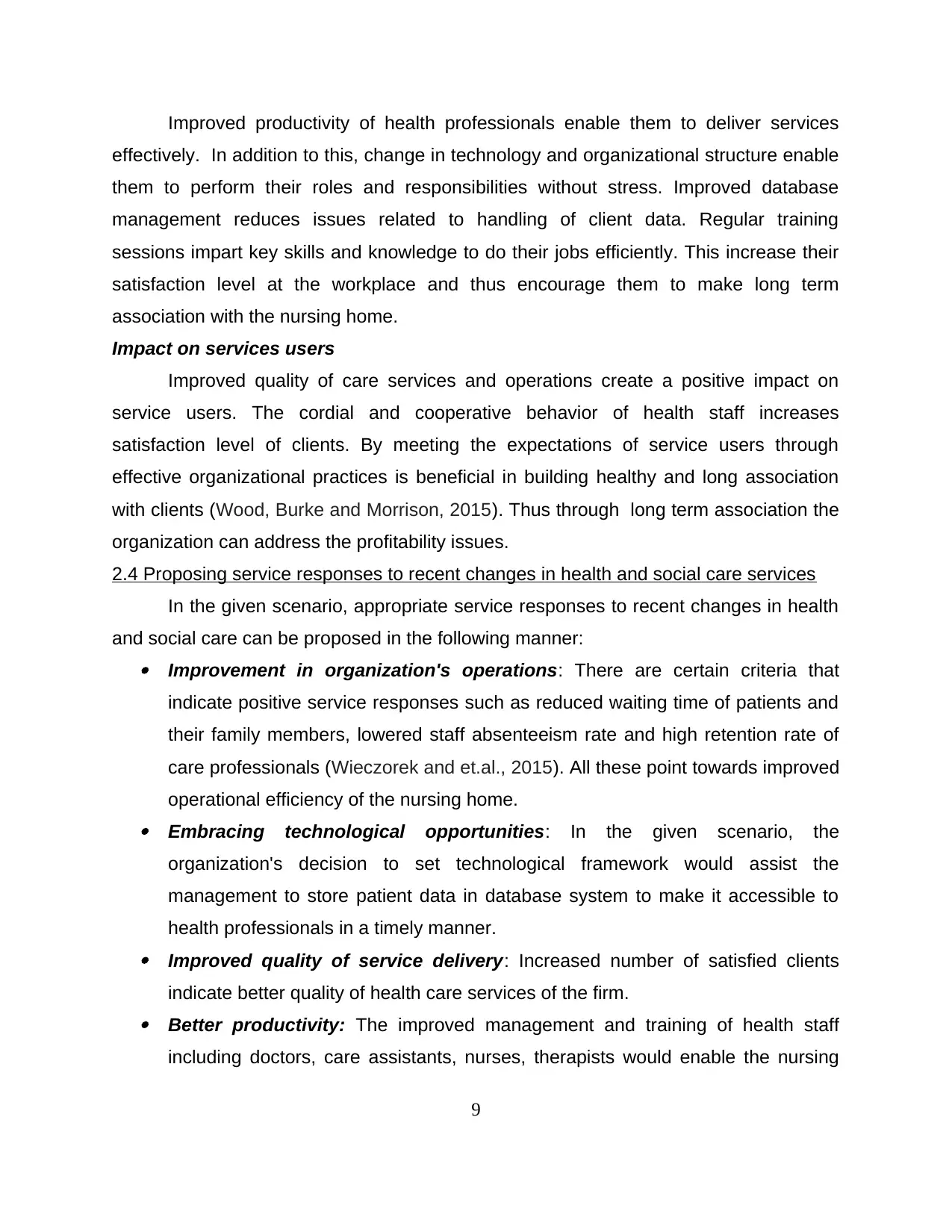
Improved productivity of health professionals enable them to deliver services
effectively. In addition to this, change in technology and organizational structure enable
them to perform their roles and responsibilities without stress. Improved database
management reduces issues related to handling of client data. Regular training
sessions impart key skills and knowledge to do their jobs efficiently. This increase their
satisfaction level at the workplace and thus encourage them to make long term
association with the nursing home.
Impact on services users
Improved quality of care services and operations create a positive impact on
service users. The cordial and cooperative behavior of health staff increases
satisfaction level of clients. By meeting the expectations of service users through
effective organizational practices is beneficial in building healthy and long association
with clients (Wood, Burke and Morrison, 2015). Thus through long term association the
organization can address the profitability issues.
2.4 Proposing service responses to recent changes in health and social care services
In the given scenario, appropriate service responses to recent changes in health
and social care can be proposed in the following manner: Improvement in organization's operations: There are certain criteria that
indicate positive service responses such as reduced waiting time of patients and
their family members, lowered staff absenteeism rate and high retention rate of
care professionals (Wieczorek and et.al., 2015). All these point towards improved
operational efficiency of the nursing home. Embracing technological opportunities: In the given scenario, the
organization's decision to set technological framework would assist the
management to store patient data in database system to make it accessible to
health professionals in a timely manner. Improved quality of service delivery: Increased number of satisfied clients
indicate better quality of health care services of the firm. Better productivity: The improved management and training of health staff
including doctors, care assistants, nurses, therapists would enable the nursing
9
effectively. In addition to this, change in technology and organizational structure enable
them to perform their roles and responsibilities without stress. Improved database
management reduces issues related to handling of client data. Regular training
sessions impart key skills and knowledge to do their jobs efficiently. This increase their
satisfaction level at the workplace and thus encourage them to make long term
association with the nursing home.
Impact on services users
Improved quality of care services and operations create a positive impact on
service users. The cordial and cooperative behavior of health staff increases
satisfaction level of clients. By meeting the expectations of service users through
effective organizational practices is beneficial in building healthy and long association
with clients (Wood, Burke and Morrison, 2015). Thus through long term association the
organization can address the profitability issues.
2.4 Proposing service responses to recent changes in health and social care services
In the given scenario, appropriate service responses to recent changes in health
and social care can be proposed in the following manner: Improvement in organization's operations: There are certain criteria that
indicate positive service responses such as reduced waiting time of patients and
their family members, lowered staff absenteeism rate and high retention rate of
care professionals (Wieczorek and et.al., 2015). All these point towards improved
operational efficiency of the nursing home. Embracing technological opportunities: In the given scenario, the
organization's decision to set technological framework would assist the
management to store patient data in database system to make it accessible to
health professionals in a timely manner. Improved quality of service delivery: Increased number of satisfied clients
indicate better quality of health care services of the firm. Better productivity: The improved management and training of health staff
including doctors, care assistants, nurses, therapists would enable the nursing
9
⊘ This is a preview!⊘
Do you want full access?
Subscribe today to unlock all pages.

Trusted by 1+ million students worldwide
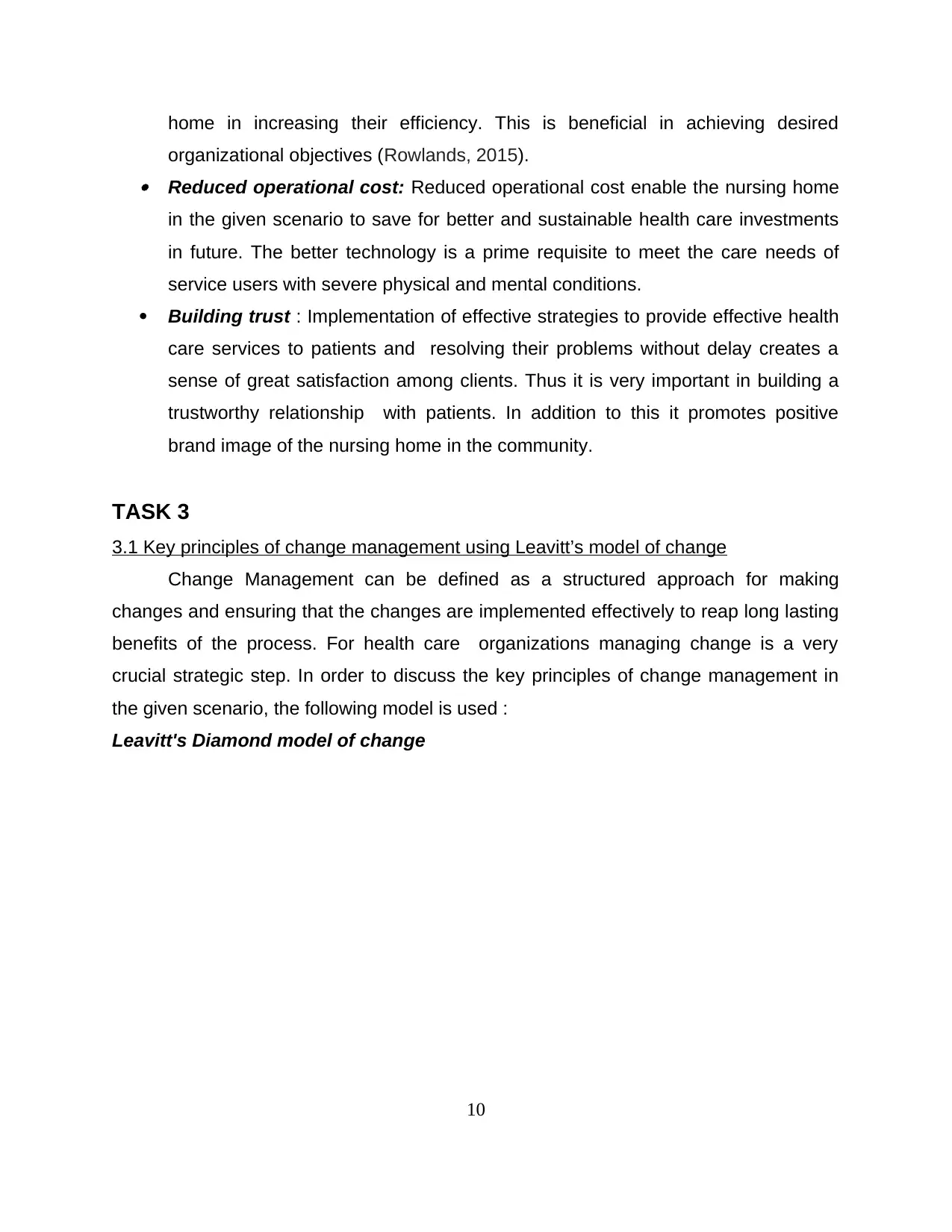
home in increasing their efficiency. This is beneficial in achieving desired
organizational objectives (Rowlands, 2015). Reduced operational cost: Reduced operational cost enable the nursing home
in the given scenario to save for better and sustainable health care investments
in future. The better technology is a prime requisite to meet the care needs of
service users with severe physical and mental conditions.
Building trust : Implementation of effective strategies to provide effective health
care services to patients and resolving their problems without delay creates a
sense of great satisfaction among clients. Thus it is very important in building a
trustworthy relationship with patients. In addition to this it promotes positive
brand image of the nursing home in the community.
TASK 3
3.1 Key principles of change management using Leavitt’s model of change
Change Management can be defined as a structured approach for making
changes and ensuring that the changes are implemented effectively to reap long lasting
benefits of the process. For health care organizations managing change is a very
crucial strategic step. In order to discuss the key principles of change management in
the given scenario, the following model is used :
Leavitt's Diamond model of change
10
organizational objectives (Rowlands, 2015). Reduced operational cost: Reduced operational cost enable the nursing home
in the given scenario to save for better and sustainable health care investments
in future. The better technology is a prime requisite to meet the care needs of
service users with severe physical and mental conditions.
Building trust : Implementation of effective strategies to provide effective health
care services to patients and resolving their problems without delay creates a
sense of great satisfaction among clients. Thus it is very important in building a
trustworthy relationship with patients. In addition to this it promotes positive
brand image of the nursing home in the community.
TASK 3
3.1 Key principles of change management using Leavitt’s model of change
Change Management can be defined as a structured approach for making
changes and ensuring that the changes are implemented effectively to reap long lasting
benefits of the process. For health care organizations managing change is a very
crucial strategic step. In order to discuss the key principles of change management in
the given scenario, the following model is used :
Leavitt's Diamond model of change
10
Paraphrase This Document
Need a fresh take? Get an instant paraphrase of this document with our AI Paraphraser
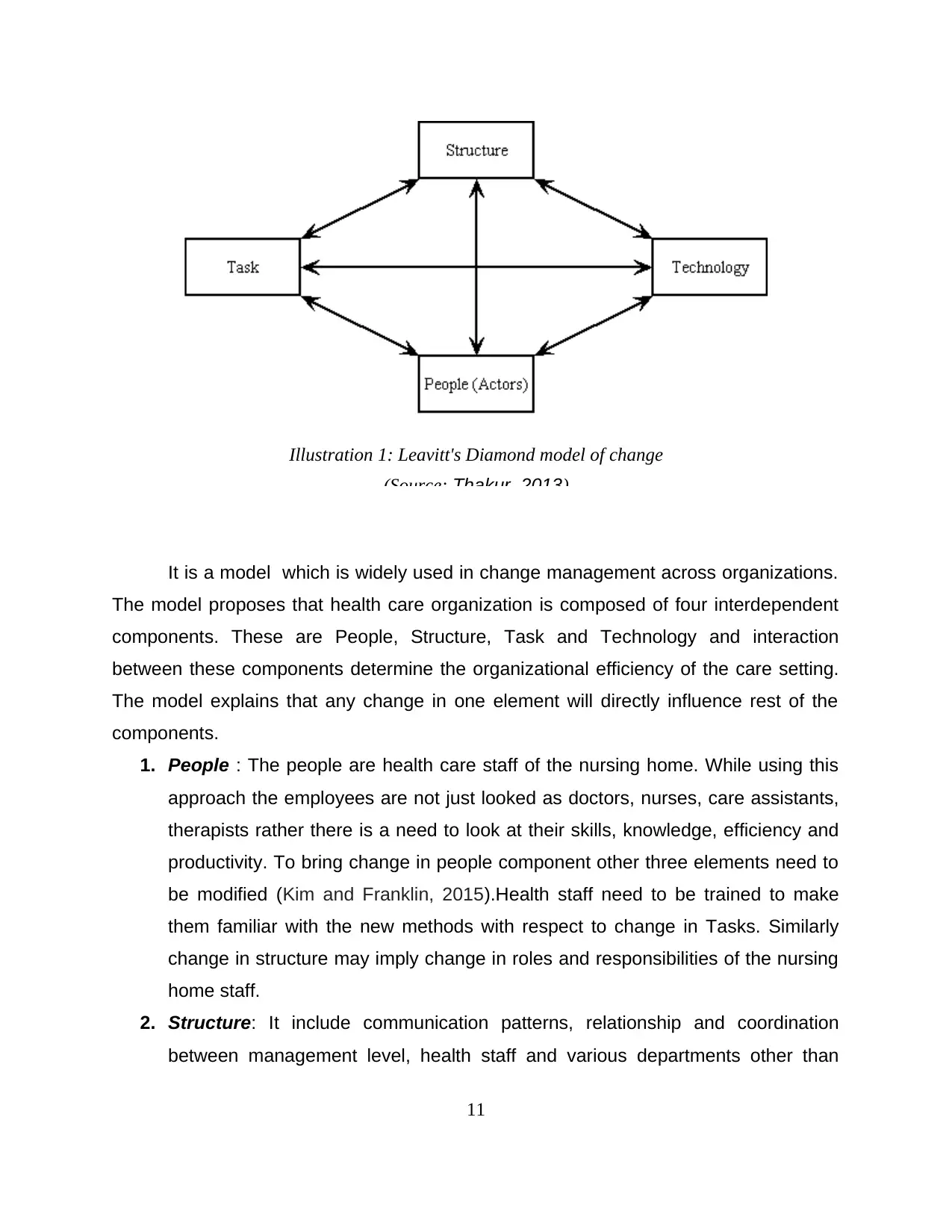
It is a model which is widely used in change management across organizations.
The model proposes that health care organization is composed of four interdependent
components. These are People, Structure, Task and Technology and interaction
between these components determine the organizational efficiency of the care setting.
The model explains that any change in one element will directly influence rest of the
components.
1. People : The people are health care staff of the nursing home. While using this
approach the employees are not just looked as doctors, nurses, care assistants,
therapists rather there is a need to look at their skills, knowledge, efficiency and
productivity. To bring change in people component other three elements need to
be modified (Kim and Franklin, 2015).Health staff need to be trained to make
them familiar with the new methods with respect to change in Tasks. Similarly
change in structure may imply change in roles and responsibilities of the nursing
home staff.
2. Structure: It include communication patterns, relationship and coordination
between management level, health staff and various departments other than
11
Illustration 1: Leavitt's Diamond model of change
(Source: Thakur, 2013)
The model proposes that health care organization is composed of four interdependent
components. These are People, Structure, Task and Technology and interaction
between these components determine the organizational efficiency of the care setting.
The model explains that any change in one element will directly influence rest of the
components.
1. People : The people are health care staff of the nursing home. While using this
approach the employees are not just looked as doctors, nurses, care assistants,
therapists rather there is a need to look at their skills, knowledge, efficiency and
productivity. To bring change in people component other three elements need to
be modified (Kim and Franklin, 2015).Health staff need to be trained to make
them familiar with the new methods with respect to change in Tasks. Similarly
change in structure may imply change in roles and responsibilities of the nursing
home staff.
2. Structure: It include communication patterns, relationship and coordination
between management level, health staff and various departments other than
11
Illustration 1: Leavitt's Diamond model of change
(Source: Thakur, 2013)
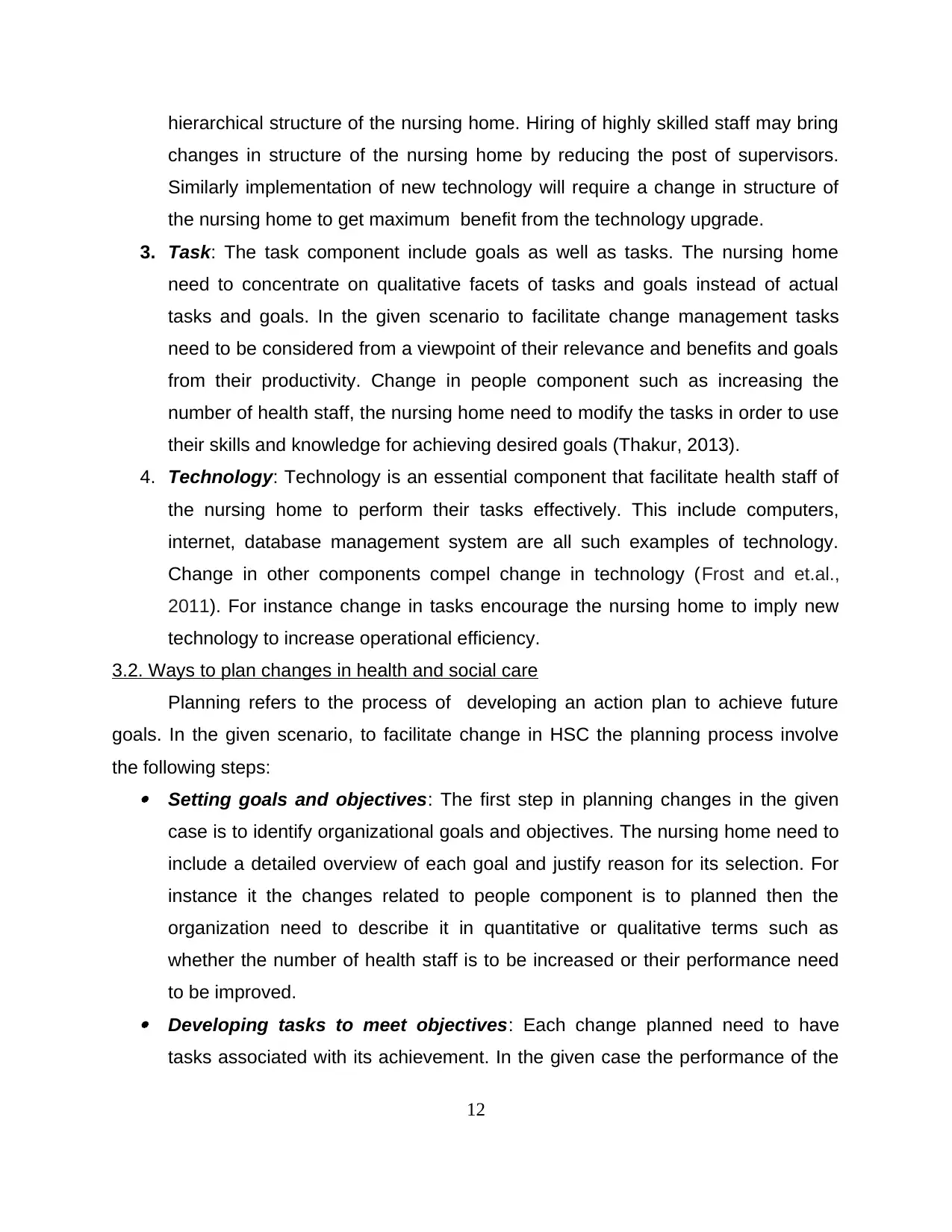
hierarchical structure of the nursing home. Hiring of highly skilled staff may bring
changes in structure of the nursing home by reducing the post of supervisors.
Similarly implementation of new technology will require a change in structure of
the nursing home to get maximum benefit from the technology upgrade.
3. Task: The task component include goals as well as tasks. The nursing home
need to concentrate on qualitative facets of tasks and goals instead of actual
tasks and goals. In the given scenario to facilitate change management tasks
need to be considered from a viewpoint of their relevance and benefits and goals
from their productivity. Change in people component such as increasing the
number of health staff, the nursing home need to modify the tasks in order to use
their skills and knowledge for achieving desired goals (Thakur, 2013).
4. Technology: Technology is an essential component that facilitate health staff of
the nursing home to perform their tasks effectively. This include computers,
internet, database management system are all such examples of technology.
Change in other components compel change in technology (Frost and et.al.,
2011). For instance change in tasks encourage the nursing home to imply new
technology to increase operational efficiency.
3.2. Ways to plan changes in health and social care
Planning refers to the process of developing an action plan to achieve future
goals. In the given scenario, to facilitate change in HSC the planning process involve
the following steps: Setting goals and objectives: The first step in planning changes in the given
case is to identify organizational goals and objectives. The nursing home need to
include a detailed overview of each goal and justify reason for its selection. For
instance it the changes related to people component is to planned then the
organization need to describe it in quantitative or qualitative terms such as
whether the number of health staff is to be increased or their performance need
to be improved. Developing tasks to meet objectives: Each change planned need to have
tasks associated with its achievement. In the given case the performance of the
12
changes in structure of the nursing home by reducing the post of supervisors.
Similarly implementation of new technology will require a change in structure of
the nursing home to get maximum benefit from the technology upgrade.
3. Task: The task component include goals as well as tasks. The nursing home
need to concentrate on qualitative facets of tasks and goals instead of actual
tasks and goals. In the given scenario to facilitate change management tasks
need to be considered from a viewpoint of their relevance and benefits and goals
from their productivity. Change in people component such as increasing the
number of health staff, the nursing home need to modify the tasks in order to use
their skills and knowledge for achieving desired goals (Thakur, 2013).
4. Technology: Technology is an essential component that facilitate health staff of
the nursing home to perform their tasks effectively. This include computers,
internet, database management system are all such examples of technology.
Change in other components compel change in technology (Frost and et.al.,
2011). For instance change in tasks encourage the nursing home to imply new
technology to increase operational efficiency.
3.2. Ways to plan changes in health and social care
Planning refers to the process of developing an action plan to achieve future
goals. In the given scenario, to facilitate change in HSC the planning process involve
the following steps: Setting goals and objectives: The first step in planning changes in the given
case is to identify organizational goals and objectives. The nursing home need to
include a detailed overview of each goal and justify reason for its selection. For
instance it the changes related to people component is to planned then the
organization need to describe it in quantitative or qualitative terms such as
whether the number of health staff is to be increased or their performance need
to be improved. Developing tasks to meet objectives: Each change planned need to have
tasks associated with its achievement. In the given case the performance of the
12
⊘ This is a preview!⊘
Do you want full access?
Subscribe today to unlock all pages.

Trusted by 1+ million students worldwide
1 out of 17
Related Documents
Your All-in-One AI-Powered Toolkit for Academic Success.
+13062052269
info@desklib.com
Available 24*7 on WhatsApp / Email
![[object Object]](/_next/static/media/star-bottom.7253800d.svg)
Unlock your academic potential
Copyright © 2020–2025 A2Z Services. All Rights Reserved. Developed and managed by ZUCOL.





